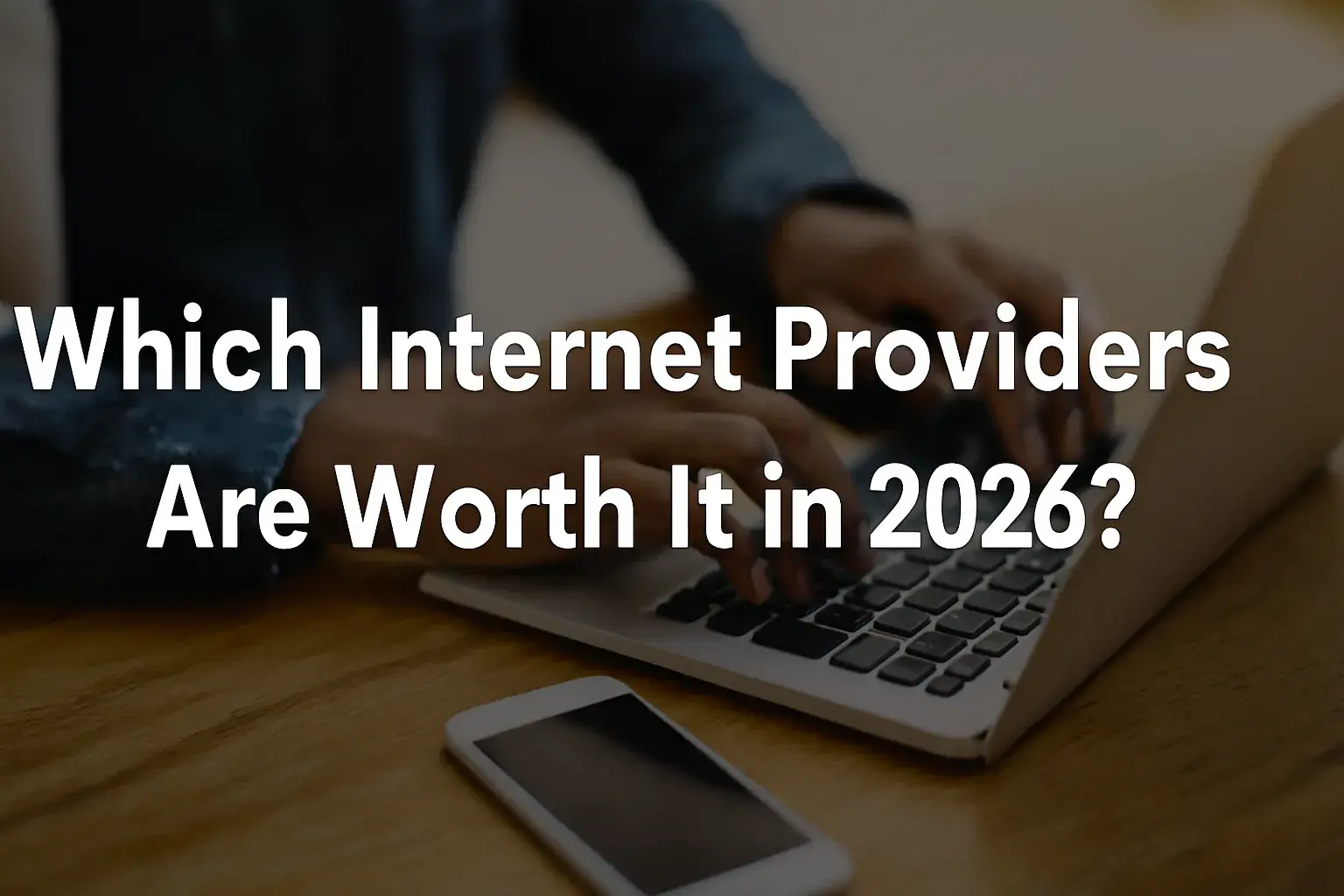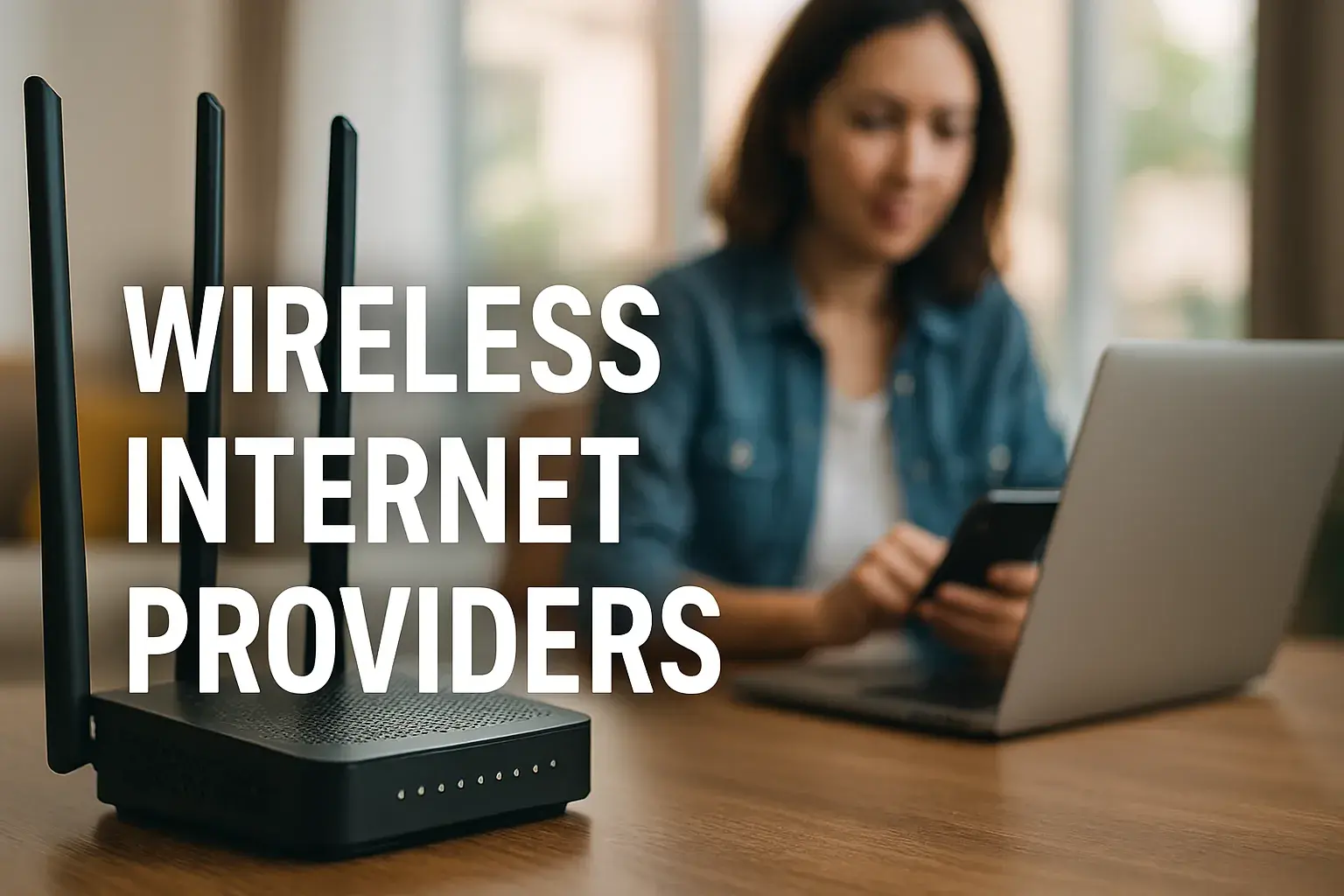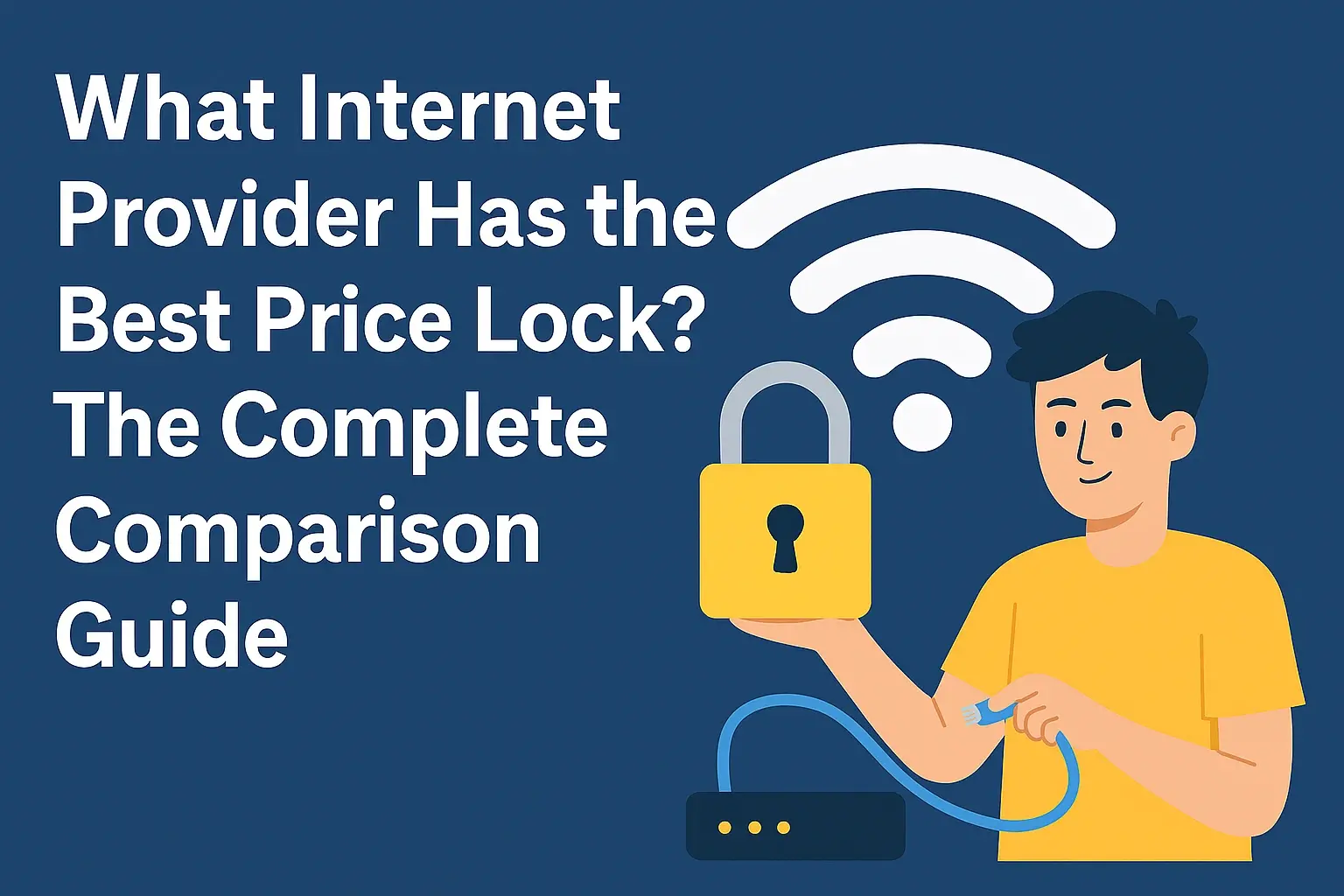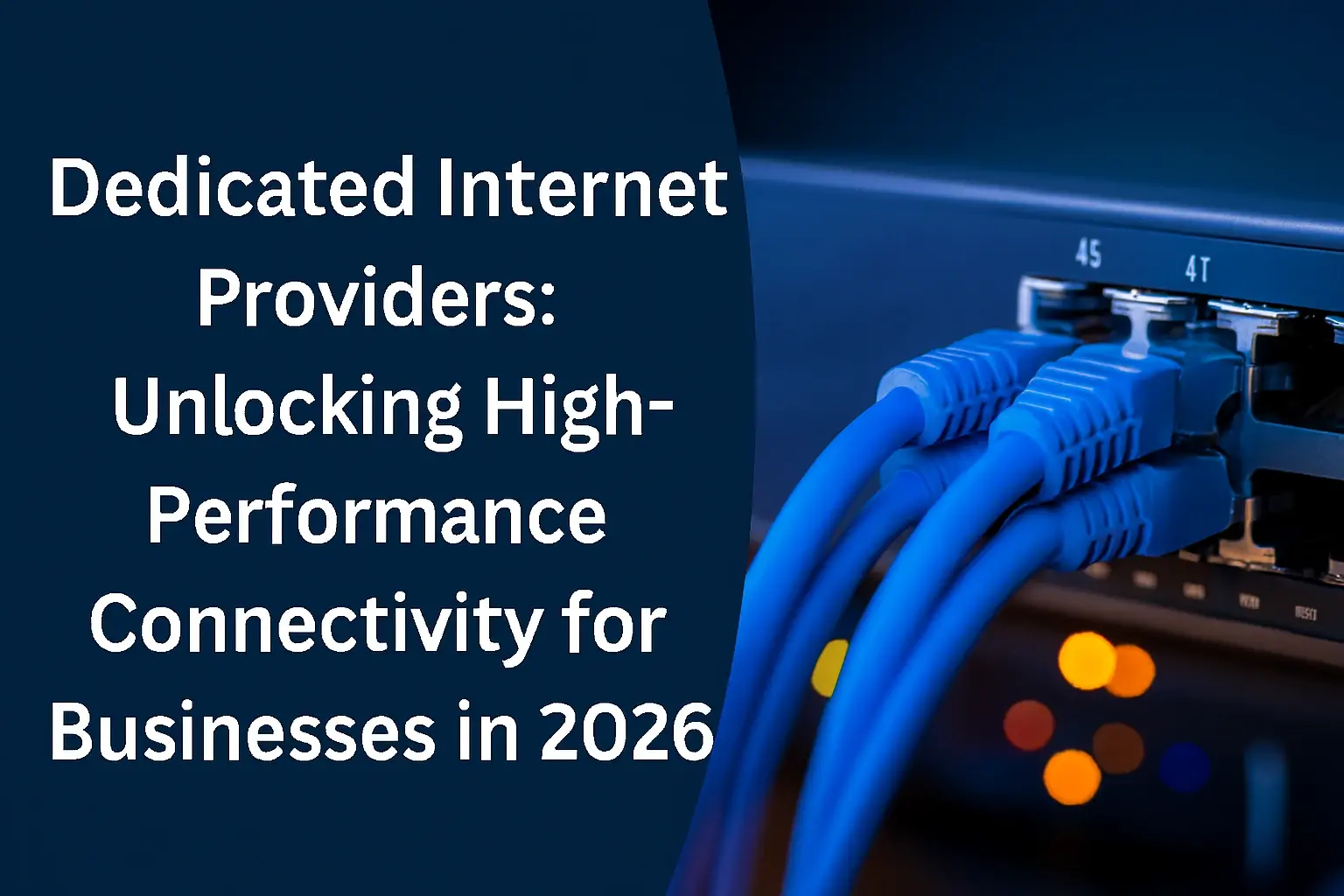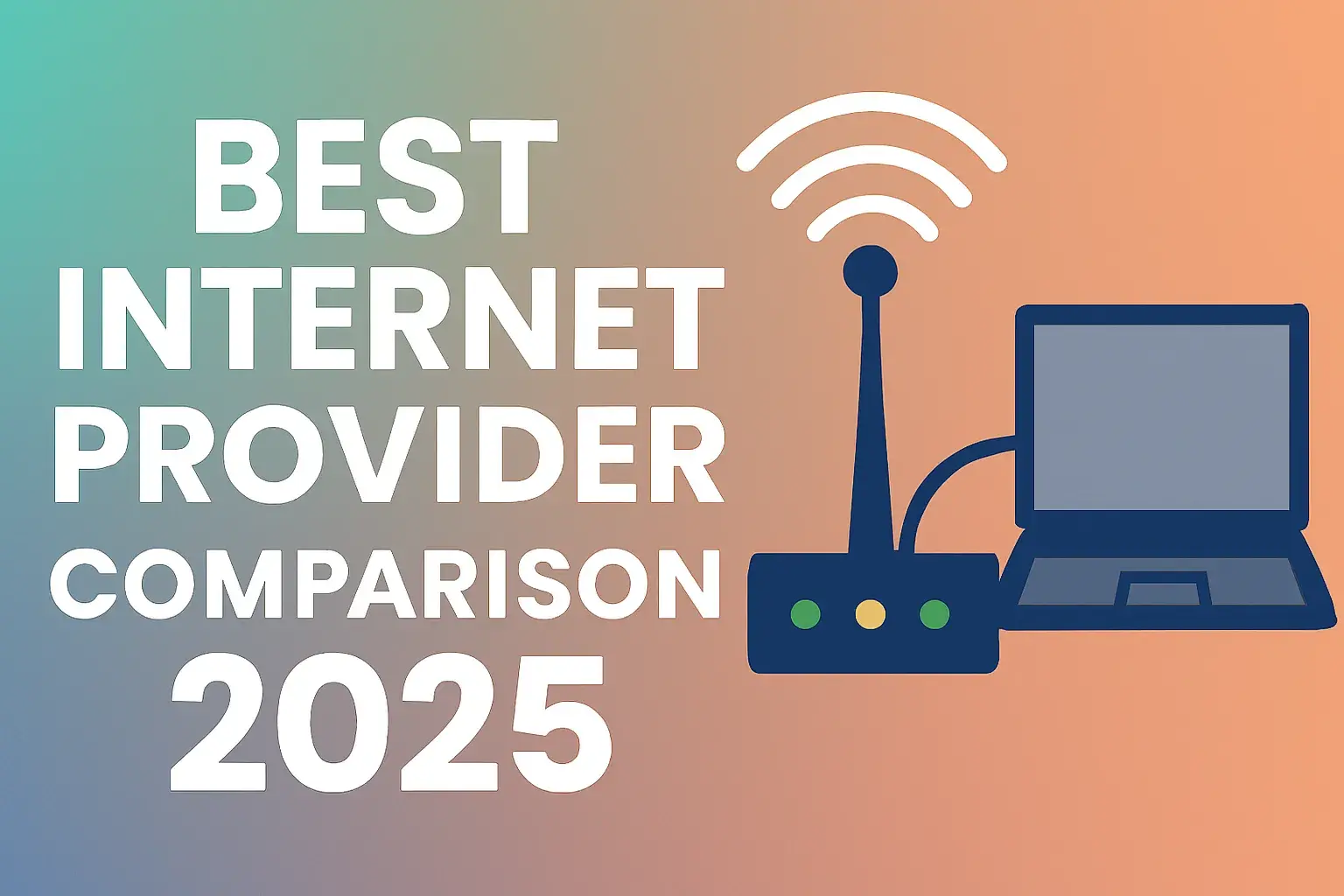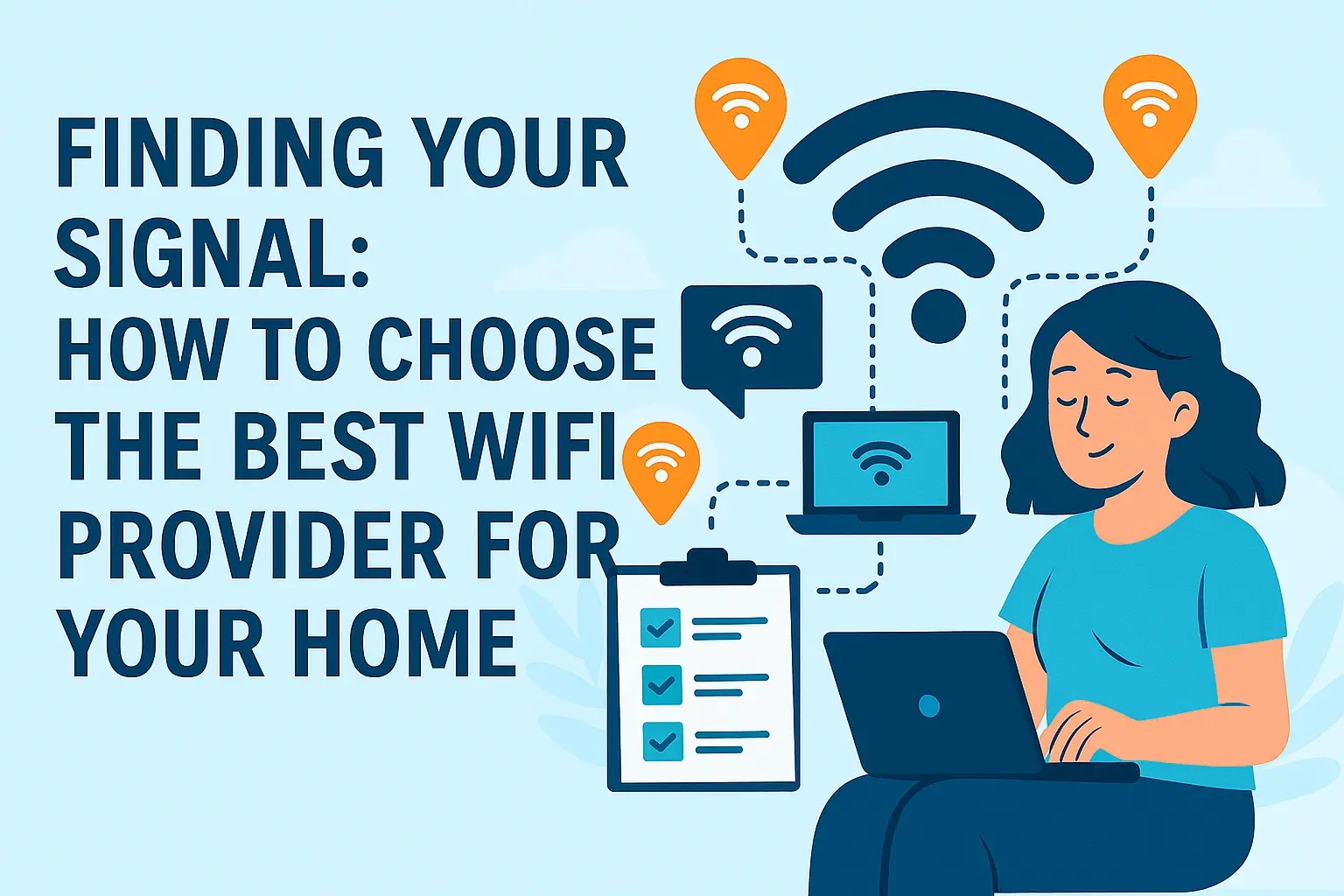
Choosing the right WiFi provider is crucial for a seamless online experience. This guide will help you navigate the options, understand key factors, and find the perfect internet service that meets your home's unique demands, ensuring you get the best signal possible.
Understanding Your Needs: The Foundation of Your WiFi Choice
Before diving into the sea of internet service providers (ISPs), the most critical step is to thoroughly understand your household's internet consumption habits. This self-assessment is the bedrock upon which all subsequent decisions will rest. Without this clarity, you risk overpaying for a service you don't need or, worse, being frustrated by a connection that can't keep up with your digital life. In 2025, with the increasing reliance on high-bandwidth activities, this foundational step is more important than ever.
Assessing Your Household's Internet Usage
Consider the number of people in your home who will be using the internet simultaneously. Each individual's online activities contribute to the overall demand. Think about:
- Number of Users: A single user has vastly different needs than a family of five.
- Device Count: How many devices are connected to the WiFi network? This includes smartphones, tablets, laptops, smart TVs, gaming consoles, smart home devices (thermostats, lights, speakers, security cameras), and even smart appliances. The more devices, the higher the potential strain.
- Primary Activities: What do you primarily use the internet for?
- Streaming: Are you constantly binge-watching Netflix, Hulu, or Disney+ in 4K? High-definition and ultra-high-definition streaming consume significant bandwidth.
- Gaming: Online multiplayer gaming requires low latency (ping) and consistent speeds for a smooth experience. Downloading large game files also demands substantial bandwidth.
- Video Conferencing: For remote work or online classes, reliable video calls are essential. This requires both upload and download speeds.
- Browsing and Social Media: These activities generally require less bandwidth but still benefit from a stable connection.
- Smart Home Devices: While individually they use little bandwidth, a large ecosystem of smart home devices can contribute to network traffic.
- Large File Downloads/Uploads: Professionals who download or upload large project files, or users who frequently share high-resolution videos, will need robust speeds.
- Time of Day Usage: Is your internet usage concentrated during peak hours (evenings and weekends) when many others in your area are also online? This can affect performance, especially with certain types of connections.
Determining Your Speed Requirements
Based on your usage assessment, you can begin to estimate the download and upload speeds you'll need. Speeds are typically measured in megabits per second (Mbps).
- Basic Use (Browsing, Email, Social Media): 25-50 Mbps download is usually sufficient.
- Moderate Use (Streaming HD, Casual Gaming, Video Calls): 50-100 Mbps download is a good starting point.
- Heavy Use (4K Streaming, Online Gaming, Multiple Users, Remote Work): 100-300 Mbps download is recommended.
- Power Users (Extensive 4K Streaming, Large File Transfers, Many Smart Devices, Professional Use): 300 Mbps and above, potentially gigabit speeds (1000 Mbps), will provide the best experience.
Don't forget upload speeds. While download speed is what you experience when consuming content, upload speed is crucial for activities like video conferencing, uploading files to cloud storage, and live streaming. For many, a 1:1 ratio of upload to download speed is ideal, but often, upload speeds are a fraction of download speeds.
Understanding Your Budget
Internet service costs can vary significantly. Consider how much you are willing and able to spend per month. Remember to factor in potential one-time installation fees, equipment rental costs, and any promotional discounts that may expire.
Types of Internet Connections: The Backbone of Your WiFi
The physical infrastructure that delivers internet to your home dictates the speed, reliability, and cost of your service. Understanding these different technologies is paramount to making an informed choice.
1. DSL (Digital Subscriber Line)
DSL internet uses existing telephone lines to transmit data. It's one of the older forms of broadband but can still be a viable option in areas where other technologies are unavailable.
- Pros: Widely available, often more affordable than other options, can be bundled with phone service.
- Cons: Speeds are significantly slower than other technologies, especially fiber and cable. Performance degrades with distance from the provider's central office. Upload speeds are typically very low.
- Best for: Light internet users with basic needs, in areas with no other options.
2. Cable Internet
Cable internet utilizes the same coaxial cable network that delivers cable television. It's a popular choice due to its widespread availability and relatively good speeds.
- Pros: Generally faster than DSL, widely available in urban and suburban areas, offers competitive pricing.
- Cons: Speeds can be affected by neighborhood congestion, as bandwidth is shared among users in a local area. Upload speeds are often lower than download speeds.
- Best for: Most households, offering a good balance of speed, price, and availability for moderate to heavy internet use.
3. Fiber Optic Internet
Fiber optic internet is the latest and greatest in internet technology. It uses thin strands of glass to transmit data as light signals, offering unparalleled speed and reliability.
- Pros: Extremely fast download and upload speeds (often symmetrical), very low latency, highly reliable, less susceptible to environmental interference and congestion.
- Cons: Availability is limited, primarily in newer developments or well-serviced urban areas. Can be more expensive than cable or DSL.
- Best for: Households with high-bandwidth needs, heavy streamers, gamers, remote workers requiring consistent performance, and those who want the absolute best internet experience.
4. Satellite Internet
Satellite internet beams data from a satellite in orbit to a dish installed at your home. It's often the only option for rural and remote locations.
- Pros: Available almost anywhere with a clear view of the sky.
- Cons: Highest latency (ping) due to the vast distance data travels, speeds can be slower and less consistent than terrestrial options, often comes with data caps and throttling, susceptible to weather interference (rain, snow).
- Best for: Rural areas where no other internet service is available.
5. 5G Home Internet (Fixed Wireless)
Emerging as a strong contender, 5G home internet uses cellular networks to deliver broadband to a fixed location. Providers are increasingly offering this as an alternative to traditional wired connections.
- Pros: Potentially very fast speeds, easier and quicker installation than wired services, can be a good alternative in areas underserved by fiber or cable.
- Cons: Availability is still expanding, performance can vary based on signal strength and network congestion, may have data caps or speed limitations depending on the provider.
- Best for: Users in areas with strong 5G coverage who want a fast, often wireless, internet solution without long installation waits.
Comparison of Internet Connection Types (2025 Estimates)
| Type | Typical Download Speeds | Typical Upload Speeds | Latency | Availability | Cost |
|---|---|---|---|---|---|
| DSL | 5-100 Mbps | 1-10 Mbps | Moderate to High | Very High | Low to Moderate |
| Cable | 50-1000+ Mbps | 5-50+ Mbps | Low to Moderate | High | Moderate |
| Fiber Optic | 100-10000+ Mbps | 100-10000+ Mbps | Very Low | Limited | Moderate to High |
| Satellite | 25-100 Mbps | 3-5 Mbps | Very High | Very High (Rural) | Moderate to High (often with data caps) |
| 5G Home Internet | 100-1000+ Mbps | 10-100+ Mbps | Low to Moderate | Expanding | Moderate |
Key Factors to Consider When Choosing Your WiFi Provider
Beyond the type of connection, several other critical factors will influence your decision and the overall quality of your internet service. Think of these as the fine-tuning elements that ensure you're getting the best value and performance.
1. Speed and Performance
As discussed earlier, speed is paramount. However, it's not just about advertised maximum speeds. Consider:
- Advertised vs. Actual Speeds: ISPs often advertise "up to" speeds, which are rarely achieved consistently. Look for providers that offer more realistic average speeds or guaranteed minimums.
- Latency (Ping): This measures the time it takes for data to travel from your device to a server and back. Low latency is crucial for online gaming, video conferencing, and real-time applications. Fiber optic offers the lowest latency.
- Jitter: This refers to the variation in latency. High jitter can cause choppy audio and video in calls and games.
- Bandwidth Consistency: How consistent is the speed throughout the day? Some providers experience significant slowdowns during peak hours, especially cable.
2. Data Caps and Throttling
Many internet plans come with data caps, which limit the amount of data you can download or upload each month. Exceeding these caps can result in:
- Overage Charges: You'll be charged extra for every gigabyte over your limit.
- Throttling: Your speeds will be drastically reduced until the next billing cycle.
- Service Disconnection: In some cases, exceeding caps can lead to your service being temporarily cut off.
For households that stream a lot of video, download large files, or have many connected devices, unlimited data plans are highly recommended. Fiber optic and some 5G plans often offer unlimited data, while satellite and some DSL/cable plans may have stricter caps.
3. Pricing and Contracts
Internet pricing can be complex. Pay close attention to:
- Introductory Offers: Many providers offer attractive low prices for the first 6-12 months, after which the price significantly increases. Understand the regular price after the promotional period.
- Contract Length: Are you locked into a 12-month, 24-month, or longer contract? Early termination fees can be substantial if you need to switch providers. Many providers now offer no-contract options.
- Equipment Rental Fees: You may need to rent a modem and/or router from the ISP. These fees can add up over time. Consider purchasing your own compatible equipment to save money in the long run.
- Hidden Fees: Look out for installation fees, activation fees, and other one-time charges.
4. Availability in Your Area
This is often the most significant limiting factor. Not all providers or connection types are available everywhere. You'll need to enter your address on ISP websites to see what services are offered in your specific location.
- Urban vs. Rural: Fiber optic is more common in densely populated areas, while DSL and satellite are more prevalent in rural regions.
- New Developments: Newer housing communities may have access to the latest fiber infrastructure.
Utilize online tools that check ISP availability by address. Remember that even within the same town, availability can vary street by street.
5. Reliability and Uptime
A fast internet connection is useless if it's constantly dropping. Reliability is measured by uptime, the percentage of time the service is operational. Look for providers with a reputation for high uptime (99.9% or higher is excellent).
- Customer Reviews: Online reviews and forums can provide insights into a provider's real-world reliability.
- Technology Type: Fiber optic connections are generally the most reliable, followed by cable. DSL and satellite can be more prone to issues.
Comparing Providers and Plans: A Step-by-Step Guide
Once you've assessed your needs and understand the types of connections and key factors, it's time to actively compare providers and their specific plans. This is where diligent research pays off.
Step 1: Identify Potential Providers
Start by researching ISPs that offer service in your area. Common national providers include:
- Xfinity (Comcast)
- Spectrum (Charter Communications)
- Verizon Fios (for fiber)
- AT&T (offering DSL, Fiber, and some fixed wireless)
- CenturyLink (now Lumen Technologies, offering DSL and Fiber)
- T-Mobile Home Internet (5G)
- Verizon 5G Home Internet
- Starlink (SpaceX satellite internet)
Don't forget to check for local or regional ISPs, which can sometimes offer competitive pricing or better service in specific areas.
Step 2: Visit Provider Websites and Use Their Address Checkers
Navigate to the official websites of the ISPs you've identified. The most crucial step here is to use their "check availability" or "find plans" tool by entering your exact home address. This will show you the specific services, speeds, and pricing available to you.
Step 3: Create a Comparison Chart
As you gather information, it's helpful to create a spreadsheet or a simple table to compare plans side-by-side. Include the following columns:
- Provider Name
- Internet Technology (DSL, Cable, Fiber, etc.)
- Advertised Download Speed (Mbps)
- Advertised Upload Speed (Mbps)
- Monthly Price (Promotional and Regular)
- Contract Length (if any)
- Data Caps (GB)
- Equipment Rental Fee ($/month)
- Installation Fee ($)
- Customer Service Rating (from third-party reviews)
- Notes (e.g., free modem, unlimited data)
Step 4: Analyze Speed Tiers
Most providers offer multiple speed tiers. Match these tiers to your previously determined speed requirements. For example, if you need 100 Mbps download, look for plans that offer at least that speed, and consider going slightly higher for future-proofing or to account for shared bandwidth.
Step 5: Scrutinize Pricing and Promotions
Pay close attention to the price after any promotional period ends. A $50/month introductory offer that jumps to $100/month after a year might not be as good as a consistent $70/month plan.
Step 6: Look for Bundles (with Caution)
Some providers offer discounts for bundling internet with TV or phone services. While this can save money, ensure you actually need and will use the bundled services. Sometimes, unbundling can be cheaper. Compare the total cost of a bundle versus purchasing services separately.
Step 7: Check for Customer Reviews and Ratings
Once you've narrowed down your options, search for independent customer reviews and ratings for each provider in your specific area. Websites like FCC.gov, Trustpilot, and dedicated tech review sites can offer valuable insights into real-world performance, reliability, and customer service experiences.
Reading the Fine Print: Avoiding Hidden Costs and Pitfalls
The contract and terms of service are often overlooked, yet they contain crucial information that can significantly impact your experience and budget. Treat this section with the seriousness it deserves.
Understanding Contractual Obligations
Contract Length: As mentioned, many plans require a 12-month or 24-month commitment. If you break the contract, you'll likely face an early termination fee (ETF), which can range from $100 to $300 or more. If you anticipate moving or might need to switch providers, opt for a no-contract plan if available.
Auto-Renewal: Be aware if your contract auto-renews. Some contracts might convert to month-to-month service at a higher rate after the initial term, while others may auto-renew for another fixed term.
Decoding Fees and Charges
Installation Fees: These can range from free (often with promotions) to over $100. Some providers offer self-installation kits for free or a nominal fee, which can be a good option if you're comfortable with basic setup.
Equipment Rental: Modems and routers are essential for WiFi. While you can often rent them from the ISP for $10-$20 per month, purchasing your own compatible equipment can save you hundreds of dollars over the life of your service. Ensure you buy a modem and router that meet the ISP's specifications for the speed tier you choose.
Activation Fees: Some ISPs charge a one-time fee to activate your service. These are often negotiable or waived with certain promotions.
Taxes and Surcharges: The advertised monthly price rarely includes taxes and government-mandated surcharges, which can add 10-20% to your bill.
Data Usage Policies
Data Caps: Understand the exact data allowance for your plan. If you have a cap, monitor your usage. Most ISPs provide online tools or apps to track your data consumption. For example, if your plan has a 1TB (1000 GB) cap and you stream 4K video for 5 hours a day, you could easily exceed it. (A general estimate is that 1 hour of 4K streaming uses about 7 GB of data).
Throttling: Know when and how your speeds will be reduced if you exceed your data cap. Some providers throttle speeds to a crawl (e.g., 1-3 Mbps), making most online activities impossible.
Unlimited Data: Prioritize unlimited data plans if your household consumes a lot of data. Fiber optic and 5G home internet plans are more likely to offer this benefit.
Service Level Agreements (SLAs)
While not always explicitly detailed for residential customers, SLAs outline the provider's commitment to service uptime and performance. For business plans, these are standard. For residential, understanding general reliability claims and what happens if service is consistently poor is important.
Promotional Period Expiration
Mark your calendar for when your promotional pricing ends. Contact your ISP a month or two before this date to negotiate a new rate or prepare for the price increase. Often, you can get a new promotion by threatening to switch.
Installation and Support: Getting Connected and Staying Connected
The process of getting your internet set up and the availability of reliable customer support are critical components of your overall satisfaction with an ISP.
Installation Process
Professional Installation: For many connection types (especially fiber and cable), a technician will visit your home to install the necessary equipment and ensure the connection is active. This typically involves running cables, setting up an outlet, and testing the service. The appointment window can sometimes be broad (e.g., 8 AM - 5 PM), so plan accordingly.
Self-Installation: Some providers, particularly for DSL and sometimes cable or 5G home internet, offer self-installation kits. These kits include a modem/router and instructions. This can be a faster and more convenient option if you're comfortable with basic setup. Ensure you have the necessary ports and power outlets available.
Equipment: Confirm whether the ISP provides a modem and router or if you need to purchase your own. If renting, understand the monthly cost. If buying, ensure compatibility with the ISP and your chosen speed tier. For optimal WiFi coverage throughout your home, consider a mesh WiFi system, which can often be used with your ISP-provided modem or a separately purchased router.
Customer Support Channels
When issues arise, you'll want prompt and effective support. Consider:
- Phone Support: The most traditional method, but wait times can be long.
- Online Chat: Often a quicker way to get basic questions answered or troubleshoot common problems.
- Email Support: Can be useful for non-urgent inquiries or documenting issues.
- In-Person Support: Some providers have physical retail locations for support or equipment returns.
- Online Knowledge Base/FAQs: A comprehensive self-help section on the ISP's website can resolve many common issues without needing to contact support.
Look for providers with 24/7 support, especially if you rely on your internet connection outside of standard business hours.
Troubleshooting Common Issues
Before contacting support, try these common troubleshooting steps:
- Reboot Your Modem and Router: Unplug both devices, wait 30 seconds, and plug them back in, starting with the modem.
- Check Physical Connections: Ensure all cables are securely plugged in.
- Test on Multiple Devices: See if the issue affects all devices or just one.
- Test Wired vs. Wireless: Connect a device directly to the router with an Ethernet cable to rule out WiFi signal issues.
- Check for Outages: Visit the ISP's website or social media for outage notifications in your area.
Understanding these aspects ensures a smoother transition to your new internet service and provides peace of mind knowing you have recourse if problems occur.
Making the Decision: Your Path to Better WiFi
You've done the research, understood your needs, and compared the options. Now it's time to make the final call. This involves synthesizing all the information gathered and committing to a provider and plan that best fits your circumstances.
Final Checklist Before Signing Up
Before you click "sign up" or sign a contract, run through this quick checklist:
- Availability Confirmed: Did you verify service at your exact address?
- Speed Meets Needs: Does the plan offer sufficient download and upload speeds for your household's activities?
- Data Caps: Is the data allowance sufficient, or is it unlimited?
- Total Monthly Cost: Have you accounted for the regular price (after promotions), equipment fees, taxes, and surcharges?
- Contract Terms: Are you comfortable with the contract length and ETF?
- Equipment Requirements: Do you need to rent or buy equipment?
- Installation Details: Do you know the installation process and estimated timeline?
- Customer Service Reputation: What do current users say about their support experience?
Negotiating Your Best Deal
Don't be afraid to negotiate. If you have competing offers from other ISPs, mention them. Ask about:
- Waiving installation or activation fees.
- Extending promotional pricing or offering a better introductory rate.
- Bundling discounts if you are considering other services.
- Any available loyalty discounts if you're switching from another service from the same company.
Many customer service representatives have the authority to offer discounts to retain or acquire customers.
The Switch: What to Expect
Once you've chosen and signed up:
- Schedule Installation: If professional installation is required, book your appointment.
- Prepare for Self-Installation: If you're self-installing, ensure you have the equipment and clear instructions.
- Set Up Your Router/Modem: Follow the ISP's instructions to connect your equipment.
- Test Your Speed: Once connected, use online speed test tools (like Speedtest.net) to verify you're getting the speeds you're paying for. Test at different times of the day.
- Configure Your WiFi: Set up your WiFi network name (SSID) and password for security.
Long-Term Considerations
Internet technology is constantly evolving. While you might choose the best option available today, keep an eye on new developments like the expansion of fiber networks or advancements in 5G technology. Regularly review your internet plan every 1-2 years to ensure it still meets your needs and that you're getting competitive pricing.
Choosing the right WiFi provider is an investment in your home's connectivity. By understanding your needs, the available technologies, and the crucial factors to consider, you can confidently find a service that delivers the speed, reliability, and value you deserve. Don't settle for less than the best signal for your home.
Conclusion: Securing Your Home's Digital Future
Finding the best WiFi provider for your home boils down to a strategic blend of understanding your unique usage patterns, knowing the technological landscape, and meticulously comparing offers. In 2025, with an ever-increasing digital footprint, a robust and reliable internet connection is no longer a luxury but a necessity. By prioritizing your household's specific needs – from the number of users and devices to the demands of streaming, gaming, and remote work – you can effectively cut through the marketing noise and identify providers that offer genuine value.
We've explored the nuances of DSL, cable, fiber optic, satellite, and 5G home internet, highlighting their pros, cons, and ideal use cases. Remember that speed, data caps, contract terms, and customer support are equally vital considerations. Don't overlook the importance of reading the fine print to avoid hidden fees and understand your commitments. Your ultimate goal should be a service that delivers consistent performance, meets your budget, and offers reliable connectivity without frustrating limitations.
Take the time to compare providers diligently, utilize address checkers to confirm availability, and don't hesitate to negotiate for the best possible deal. By following the steps outlined in this guide, you're empowered to make an informed decision that will enhance your home's digital experience for years to come. Secure your signal, and embrace a faster, more reliable online world.
